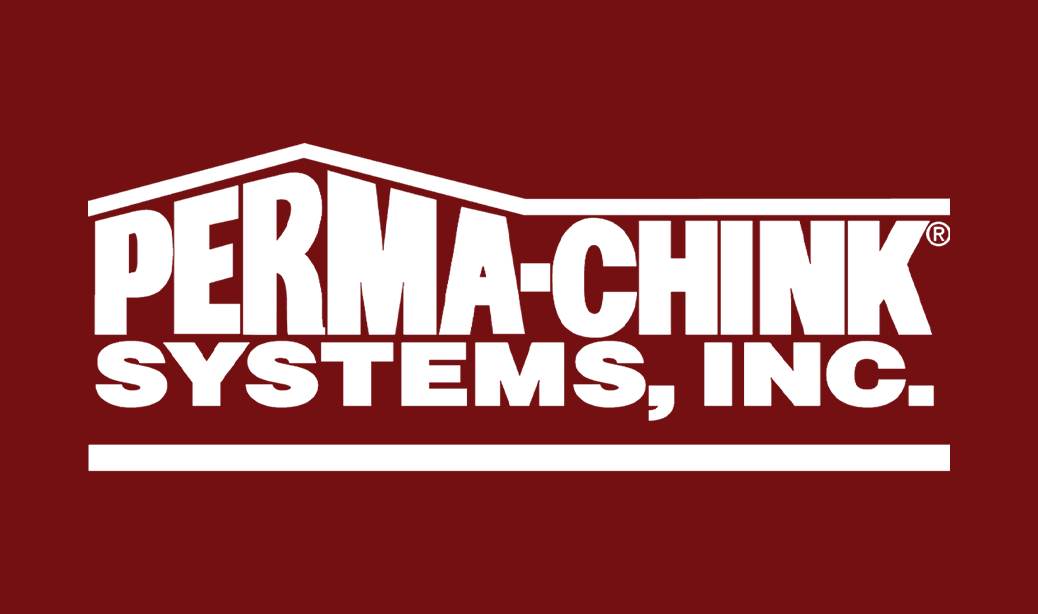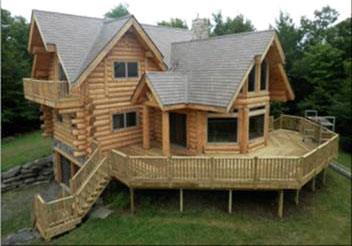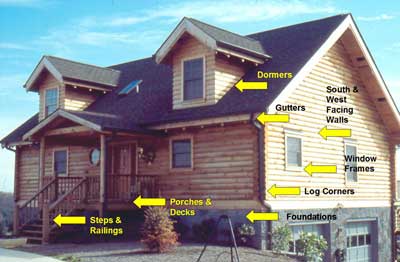Blog
My name is Mike Samuels. I am a Log Home owner and recently started working for Perma-Chink Systems. So let me tell you how my story begins. We are going back to my childhood. My parents vacationed in Smoky Mountains once or twice a year. As a child I was very impressible and excited any time I was able to go on vacation. The trip always included a drive through the mountains, sightseeing around Cades Cove and driving up the most treacherous Ski Mountain Road.
On every visit to the Smoky Mountains, I remember making comments to my mother that one day when I grow up, I would have a log home or mountain chalet here. I made a lot of wishes to my mother growing up just as any kid does. I am sure that my mother listened to my comments in one ear and out the other. She was always very encouraging. I also remember that I told her I would be an US Air Force fighter pilot. Not everything comes true, but there is nothing wrong with dreaming.
I worked for one company for 38 years, mostly living in Houston, TX but my wife, Kathy, children and I lived in Tennessee for a total of 10 of the 38 years. Unfortunately the Tennessee years were located in the middle and west Tennessee, never East Tennessee. However, many of our family vacations were still in Smokies. My children were overwhelmed with the breathtaking views of the mountains as much as I was as a child.
Fast forward 40 years. Where did the time go? It was finally time to think about retirement and where my wife and I would spend the remainder of our lives. The decision was not as easy as one would think. The first place many people want to retire is the beach. That was our first idea, but Kathy and I looked at each other and simultaneously we said, How about Smokies, and How about a Log Home?
Kathy immediately logged on to the Internet and starting looking at land for sale. I can tell you that once my wife has a mission, she reacts quickly and thoroughly. Within minutes she found several pieces of property for sell. Of course, this would mean another vacation to Smoky Mountains to look and buy land. She planned out a trip, contacted a Real Estate company and put everything in motion.
We picked out approximately 10 properties to look at. Our real estate agent met us at the hotel around 8am on a Saturday. An early start was essential in order to look at all of the properties in a couple of days. It was rainy and cold. I believe the trip was in March, the best I can remember. We made it to all of the properties on Saturday… a very long Saturday. Kathy and I were a little car sick from the winding mountains roads and disappointed, because none of the properties made any significant impact on us.
Early on Sunday morning the rain had stopped so my wife and I decided to go out and search on our own for the perfect piece of land. What a difference does good weather makes. Kathy and I parked the car and started walking. We made it about half way up the property and were able to see nothing but trees and hillsides all around. We envisioned how a house would sit on the hillside. We walked up to the top of the hillside and there was this great view of mountain tops. At that time, we knew this was the right property to build our log dream home and spend the rest of our lives here. We made an offer, countered and purchased the same day on a Sunday.
As I mentioned earlier, Kathy is not one to sit back and wait for things to happen. She now has the land. It was time to start planning next steps. We both were still several years away from retirement but that did not stop us. She continued to plan. She contacted what seemed to be 100 manufactures, builders, and purchased tons of Log Home magazines and publications. Being a good husband, I sat back and allowed her to make floor plan decisions and building styles. I knew that my goal in life was to keep her happy. The design of the house was not my main concern. I like spending time outdoors, so as long as I had a place to eat and sleep I would be happy. We lived in five different homes but never one that would take on this feat. Most of our home purchases were buying new and vacant so we could move right in.
Meanwhile, while Kathy was doing all of the Log Home research, we decided to get started on all the work it takes before you start to build. After Kathy compiled all of the Log home information, we could see our vision beginning to be a reality. First, we decided to have the land re-surveyed. A small price to pay for the comfort you got what you paid for. We were still six to eight years away from retirement and building. Our goal was to build and have the home complete about one year before our retirement. We wanted to work to age 58 before retiring and moving to the mountains.
Kathy and I vacationed about every six to eight weeks. All vacations now were, not to beaches or cruises, but to our piece of land heaven in the Smoky Mountains. After our first visit in the fall, our land was so overgrown we could not even walk on it. Vacationing to our future home was the worst thing we did, because at that time we decided to begin doing some excavation work. Living far away from your land is really a detriment. The key is finding good contractors, which is very difficult even without the distance between Houston, TX and Smoky Mountain Tennessee. In the case of identifying good contractors, “The more the Better”.
Our surveyor gave us a name of a contractor who could excavate. We call the excavator out along with about three other contractors to discuss options. We did end up with the contractor our surveyor recommended. Instead of only clearing land, we installed the septic tank, laid out the driveway, cleared about one acre of land and set the home site. Keep in mind that Kathy was still working on log home designs and floor plans, not to mention taking me many miles around the region to see and talk to log home manufacturers and look at model homes.

Our next vacation visit to the land was to see the outcome of the excavator’s work. The land looked fantastic. No longer did we need to walk up the hill and fight our ways through the heavy brush. We drove our car up the driveway and parked where one day the house would be. These vacations to the land made us want to build and move sooner than we planned. And we did.
After meeting and talking with several contractors we decided to go with someone who had extensive Log Home experience and managed a Log Home Resort complex. He was going to be our eyes on the ground. My wife actually took the role of general contractor. She did an amazing job. She ordered the Log home package, had it delivered and the log home manufacture completed the dry-in. A lot of work had to take place prior to the package being delivered. We decided to build the home into the hillside and build a basement garage under the home. Our excavator and surveyor had more work to do. Get the retaining walls, garage and basement ready prior to the delivery of the log home package. Our surveyor read the plans to install supports for the balcony and decks.
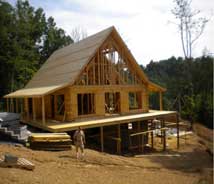
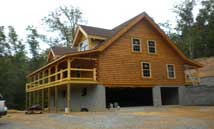
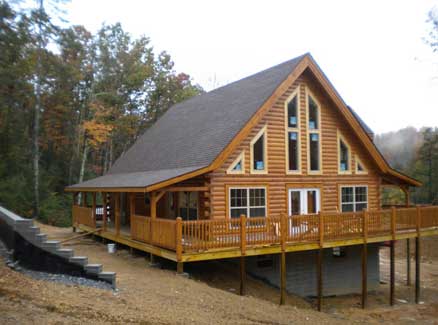
I wanted to get the home stained as soon as the dry-in was completed. Applicators in the area had many recommendations on which log home stain to use. Again, my wife and I did research on wood stains. After reading propaganda from websites we decided on Perma-Chink Systems products. Our decision was based primarily on a water-based product, especially when we saw the warranty available for Lifeline Ultra stains. Perma-Chink Systems was the only company that guaranteed their stain with a 5-year warranty if properly applied. Fortunately my eye on the ground in Smokies was also a Perma-Chink Systems distributor. I let my wife pick out the color. After 30+ years of marriage, I finally learned my lesson, “Keep a Wife Happy”.
Perma-Chink Systems delivers an excellent product, good warranty and ease of cleanup. All attributes of a good log home stain. Since Perma-Chink Systems has a family of products we felt that their overall systems were a good match for protection and longevity. We chose Dark Natural color in the Lifeline Ultra-2 line. We started with the Shell-Guard borate treatment, Log Wash wood cleaner, Lifeline stain and Advance gloss top coat. The house looked great.
One month after I turned 55 years old, we retired and now living in our new Log Home. Looking back on all of the hard work, frustrations, time spent, and even the occasional husband and wife arguments, we finally made it. It has been great living in a Log Home. What makes it better, is that my daughter purchased a log home about 10 miles from us on the lake. It is nice having family with you during your golden years. By the way, I stripped and stained her home using Perma-Chink Systems products as well.
I have learned so much about log home maintenance and care for a Log Home. So much, that when I visited our local PCS store to get Log Wash, I also got a job. I am one of the newest employees here and I am still learning how to maintain our home.
My biggest lesson for anyone wanting to build a log home is planning, from start to finish. Attend as many log home seminars that you can. Perma-Chink offers excellent seminars for the do-it-yourself home owners. Take advantage of the Perma-Chink Systems experts and utilize their personnel to get valuable advice. Call or visit any of the locations to get personalized service. Call me at the Perma-Chink Systems in Sevierville, TN. I will be happy to share my experiences and will guide you for a long and happy life in your Log Home.

After graduating from college, the normal progression for most women is marriage. But, what is great, or even fun, about being normal? This neo-Laura Ingalls-Wilder, this Backwoods Barbie, embarked upon an adventure. I decided to build a log cabin!
I have had the pleasure of being around log cabins nearly my whole life. I grew up in my parents’ pine, D-shaped log cabin. They had a “turn-key” package; but we, mainly my father, ended up doing a lot of the work. Despite three children, pets, and fluctuating Alabama weather, their home has weathered nicely with little maintenance. Therefore, my parents are supportive of my log cabin, although they enjoy ribbing me about some comments I made when I was about ten years old.
I was ticked at my mother because she did not think that a black and silver waterbed (completed, of course) with a zebra bedspread was suitable décor for a ten year-old girl’s log bedroom. Thus, I declared that I would never have a house of wood. I vowed to have only wallpaper and paint in my house one day. (Never say never!)
Anyway, my adventure started when I found an ad for oak log cabin kits in a classified newspaper. Not wanting to be saddled with a large debt and realizing that I would be responsible for cleaning and maintaining the house, I decided to purchase the approximately 1,500 square-foot kit. The logs arrived safely and beautifully – Missouri oak heartwood dovetail logs.(Say that ten times fast!)
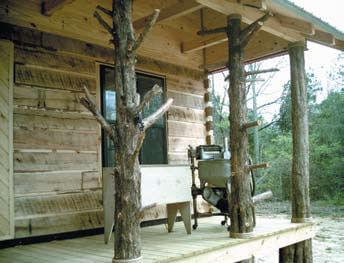
Since my kit consisted of only the perimeter wall logs, I drew the interior plans one Sunday afternoon; and Mom and I devised a plan that would allow me to “pay-as-I-go” and have the cabin completed and paid-off in three years. However, I did not realize how much I was going to be involved with the “hands-on” construction, and I never imagined how much I would learn to do and end up doing myself.

I hired an experienced carpenter to oversee my project (I later hired some helpers for a few days). My brother Tubby and the carpenter laid the block, and I started helping with the setting of the logs. Tubby would sing “John Henry” as he swung the sledge hammer! Our carpenter joked, saying he felt like he was building a pyramid. Dad, Mom, and I cut cedars for the porch posts (Mom and I caught poison oak to prove it) and hemlocks for the supporting interior posts. I wanted some octagon windows, but I could not justify the special order price. However, I found new ones (although the wrong color but paint corrected that) at a flea market for 1/10th the special order store price. Mom and I shopped ‘round and ‘round for the additional lumber at the best prices.
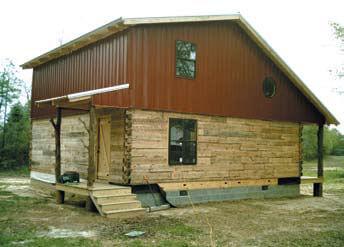
Before Mom and I started preserving the logs and additional lumber, Mom and I attended a Perma-Chink Systems workshop in Rome, Georgia. We learned countless tips and acquired useful information that has saved me both valuable time and money. (My father was very impressed when I informed him of what pressure-washing tip, at what pressure, and at what angle I had to wash the logs.) Mom and I painstakingly followed all the Perma-Chink products’ directions. The Energy Seal far surpassed any other similar product in both ease of application and appearance during the sealing of the dovetail corners and joints. This very time-consuming task made me feel like the “Human Dirt Dauber,” and I lost track of how many hours I spent on this job. However, my leaks during pressure-washing were mostly confined to around the windows and doors that had not been trimmed at that time. The Log Wash, Wood ReNew, Armor-Guard, Log End Seal, Lifeline Ultra-2 exterior stain, Lifeline Advance clear topcoat and Cobra Rods were quickly and very easily applied or utilized.
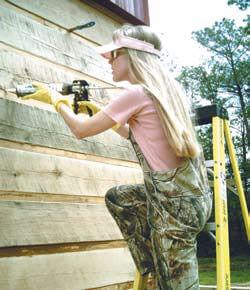
Painting the 2X4’s with Chink-Paint was another time-consuming task. I completed this step fully by myself. If stacking the logs felt like building a pyramid, this step could be compared to engraving the hieroglyphics onto the stone pyramid walls. (One thing I quickly learned during chink painting is that it is much better to paint slowly and clean-up less than to paint quickly and clean-up more!) Mom and I were both surprised and impressed with the Lifeline Advance Exterior Gloss topcoat. When we cleaned out the containers from which we were applying, the dried Lifeline Advance peeled out like plastic wrap. I feel as if my cabin is securely plastic-wrapped from the elements.

The interior Perma-Chink Systems products worked as well as and look as great as the exterior products. Prelude beautifully prepared the interior logs for the Lifeline Interior stain. The Lifeline Interior stain and the Sure Shine Gloss look fantastic on the many different types of interior wood – oak, pine, spruce, hemlock, and hickory. The Chink Paint also looks nice on the interior walls.

With the assistance of good helpers and the employment of recycling, creativity, gifts from generous friends, and affordable Perma-Chink Systems products, the exterior of my cabin is already completed and much of the interior is completed in only six months. My cabin is debt-free and is more beautiful than I ever dreamed that it would be. Before preserving the logs, I was concerned that by doing anything to the logs, I was going to destroy their natural beauty. (Boy, was I mistaken!) The Perma-Chink products are not only protecting, but also enhancing my logs’ natural beauty. Before using some of the products, I doubted the necessity of using them. (Boy, was I mistaken again.) Each easily applied Perma-Chink Systems product is necessary for a beautiful, protective complete finish.
My adventure has changed me both mentally and physically. I am stronger, wiser, more grateful, and more selfsufficient. It has given me a strong sense of accomplishment. When someone asks me about my home, I am able to show them my hands and say that I’ve built my cabin with these two hands (despite the nail polish) and with the help of some good folks and great Perma-Chink Systems products.
“The Wise Woman Builds Her House” PROVERBS 14:1
By Mala Patterson,
Bluegrass Musician
The Leroy Mountain project was in need of some help. Built in 2003 it had been coated with Sansin Classic. One product, one color had been used on everything- logs, trim, and deck. This resulted in a mono-tone appearance. A second and third coat had been applied over the years, without adequate preparation. On one wall it looked like the finish had not been stirred or mixed before applying. Time, sun and weather had degraded the exterior badly. It was sad to see such a beautiful home in this condition.
My first impression on seeing the house was “Whoa, what is that little gem doing here?” Large Doug Fir logs, scribed fit, three gables, two balconies, two dormers, two porches, hexagon great room and deck – all tucked in on a basic footprint of 32’ X 32’. This is not your typical Pennsylvania log home. The log kit was supplied by The Log Connection, British Columbia, Canada. As soon as I saw it I knew we could bring it back to better then new looking condition.
The first step was cleaning the home. Seventy eight bags of New Age crushed glass blasting media were used to remove all the old finishes from the logs and deck. Next we sanded the logs down using random orbital sanders with 60 grit and then an Osbourne Brush. Special attention was paid to the logs ends, smoothing them out and chamfering the edges. We also smoothed out all the deck top railings, posts and hand rails to ensure a nice feel when touched.
Porcupines had climbed all the log corners and chewed some pretty large areas. Some spots could be sanded out, others were repaired using M-Balm and E-Wood. After sanding the E-Wood smooth I brushed a light coating of Energy Seal over the repaired area so that when stained it blended right in.
We soaked the bare logs with thirty gallons of ShellGuard RTU then sealed all the log courses, corners and intersections with six pails of Energy Seal “Adobe”. The house was then washed with Log Wash and allowed to dry.
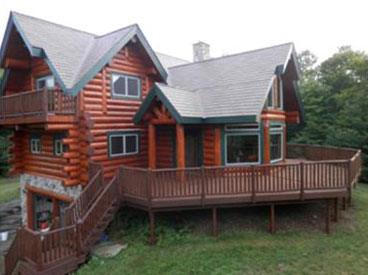
First coat of finish required fifteen gallons of Prelude, a clear primer/sealer with UV inhibitors. Two coats of Lifeline Ultra2 “Bronze” were next, requiring twenty three gallons. The last coat was nine gallons of Lifeline Advance Gloss. All finishes were sprayed on using a Graco Tradeworks 170 with a 313 tip and back brushed with a StainMaster brush.
Window trim and fascia were painted with Sherwin Williams Super Trim Paint in a rich, deep, pine tree green. This extra step did require a lot of time and effort but really set off the details of the home and complimented the color of the logs.
Deck and railing were coated with twenty five gallons of “Hickory” Deck Defense.
The project took one man, six weeks, 317 hours to complete. When I started the project in late July I did not have a firm deadline nor did I know of the family reunion occurring on Labor Day Weekend. I really had to hustle to finish, putting the final touches on the deck just in time. It was worth the effort, as the owners and his extended family love their better then new home.
Brian O’Shea
Log Home Restoration
Wellsboro, PA
Hi Greg! I wanted to thank you for your patience and the assistance you provided regarding staining our log home. Your guidance was extremely helpful. It’s people like you who make it a pleasure doing business with Perma-Chink Systems.
Audrey N
Tallahassee, FL
Jimmy, thank you for your excellent, courteous and well informed communication. You were able to work with a very unique situation in a very respectful way, and I appreciate that. I would say that Perma-Chink is lucky to have you in their Customer Care Department!
Susan H
Fairfield, IA
Since 2001 I’ve been blessed to be able to build log homes. Perma-Chink products have enhanced this fun, adding security in quality products and aesthetics in the beauty of your true colors. Integrity and reliability are cornerstones of your products. Thank you Greg and Perma-Chink!
Mary M.
Dalton, GA
By Tony Huddleston
VP of Sales and Operations, Perma-Chink Systems
Log home living in today’s world can be linked to the same pioneer spirit that helped many of our ancestors forge a new world. The spirit that dwells in so many of us tells us that we want something different from all the rest. Something that enables us to have a different way of expressing our lifestyle that embodies the individuality in some of us that separates us from the masses.
The months or years that are spent researching log home styles, construction methods, visits to dealers and talking with homeowners about their homes are brought to reality when we finally move into a new log home. Hopefully during our quest for the home we wanted that our dealer advised us to plan for maintenance and to design our homes to be “maintenance friendly”. After all we, like our homes are not going to be forever young, so planning for maintenance down the road will pay off big dividends in years to come.
Today’s log homes are not the same homes our ancestors built, as they were often built strictly as a necessity for their families. There were very few thoughts as to anything other than shelter and protection from the elements as well as other predators. Log homes of today are engineered to be structurally sound and take advantage of energy-saving features, much the same as other homes. They are no longer viewed as “cabins”; they are primary homes and second homes or vacation getaways.
Having said that, all of the engineering, planning, and choices you make should also include planning for scheduled maintenance on your home. Maintenance should not be viewed as a chore or just an expense, it should be considered as an investment in your homes’ longevity and value. Properly cared for; log homes will appreciate in value, rather than depreciate. Download the “Inspection Checklist” in PDF here.
If you are new to the lifestyle of log homes, then possibly you may be new to the care and feeding of a log home and may have some questions or reservations as to how this should be done. With a little planning and timely execution it is not as difficult as it may seem.
Starting with the basics; a walk around your home at least twice a year will help you become acquainted with your home and the condition of the sealants and finishes. If you do see something, get up close and personal to see what is happening. Pay close attention to the South and West sides of your home as that is normally the areas that catch most of the sun, and the ultraviolet rays that come with sunlight will cause those areas to show the quickest signs of needing maintenance. Many folks are under the impression that you always have to re-stain the entire home; when in fact all you may need is a touch up on the weathered side.
During your walk around, pay attention to the sealing system on your home, especially around doors and windows. As checking and fissure development is a naturally occurring process in large timbers, make note of any checks that face upward to catch water and hold moisture that may cause problems. Take special note of any that run behind door and window trim that may allow moisture to work its way to the interior. Also look for any telltale signs that your stain or finish is beginning to need attention; fading, peeling, or dark areas under the finish are good indicators that mean it is time for a maintenance coat.
Plan on washing your home at least once a year to remove all pollen, dirt and other airborne pollutants that may have settled on the surface, and no it does not always mean you have to pressure wash the home. Log Wash™ and a garden hose will remove most unwanted contaminants without hurting your homes finish. Many of the cleaners available today are not suited to clean your home, as they are often very aggressive and may contain chemicals that will be harmful to the finish as well as the landscaping. And contrary to some popular beliefs, bleach is not a cleaner and should not be used as it is not only dangerous to the user, but it also harmful for the environment and the wood on your home.
Any landscaping such as shrubs, bushes and vines should be trimmed back so as not to interfere with air circulation on your walls. The walls should be allowed to have good air circulation and landscaping that is touching the home will; over time scuff the finish and provide too much moisture to remain on the surface.

Remember those upward facing checks mentioned earlier? Those should be filled with Check Mate 2™ as it will standup to the natural opening and closing movement during climatic changes in weather. Inexpensive caulks may not fill the bill in this application, and actually may do more harm than good by creating troughs to catch even more water. Select a product that is designed for that purpose; and follow the directions provided to achieve success. Again any sealant that needs replacing or repairing should be done at the same time as well.
While you are doing your walk-around; look for any evidence of insect activity that could be the start of some unpleasant results. Things to look for include sawdust or “frass” that may be left from the activity of powder post beetles, also look for any signs of termite tunnels that lead from the ground up to the base log or lower plate. Take the proper action to eradicate these types’ of pests by calling the local pest control guy to help you with removal and prevention. Carpenter ants are pesky insects that do not actually eat the wood for food purposes, but they do damage by creating nesting areas in and around the home. Keeping your finish in good shape to prevent moisture accumulation will help to deter these pests, and all insects need water to survive. Store firewood away from the house as it is a haven for insects.

In today’s economic situation, energy conservation has become paramount due to higher energy cost, so you might consider having an energy audit on your home that includes a blower door test to locate any areas that are allowing air to enter or leave the home. In case you are wondering what a blower door test involves, a technician will install a seal over one door in your home and draw a vacuum on the entire structure. Once a certain level is obtained they will use an infrared camera and check for temperature changes that may indicate a leak. The results will be entered into a software program and it will be determined how much energy you may be losing, and solutions will be offered as to remediation. Many of the leaks can be easily sealed or eliminated by other means, so it does not always involve spending a lot of money. And yes, all homes and buildings do leak in some areas, no matter what construction type they are.
In summary, creating a simple maintenance plan for your home will eliminate the need for more expensive maintenance needs as time goes on. As the very old saying goes, “an ounce of prevention is worth a pound of cure” is also true on log home maintenance. Keep it simple, and keep it small and your home will love you for it.
Perma-Chink’s customer service provided by Billy Cash and Jimmy Kennedy has been outstanding, and the products are excellent. We are a new build and have used all Perma-Chink products on our exterior as well as interior throughout our build and are very well please with the application and performance. We have personally done all work on staining and sealing since being jilted by a contractor, so we are pleased to have Perma-Chink by our side throughout this process!
Sonja & Steve L
Cleveland, TN
“I wanted to drop you a line and let you know about the good feedback we have had on the Perma-Chink’s Energy Seal caulk. When our customers come into our office, they’re able to compare all of the different caulk lines that we carry. Due to the great variety of color options, Energy Seal is typically a winner for them. Our customers report that they like the texture of the caulk and the ease of application. I also want to thank all of the Perma Chink staff for the quick and friendly service we always receive on our orders. Keep up the great work, and I look forward to a great year forward!”
Kathy Webb
Twin Creeks Log Home Supply, Inc.

